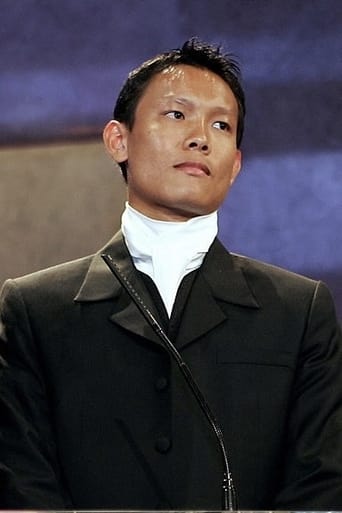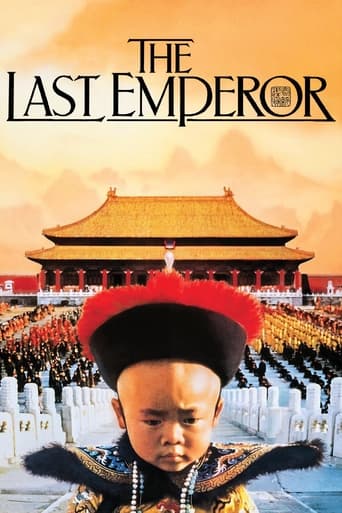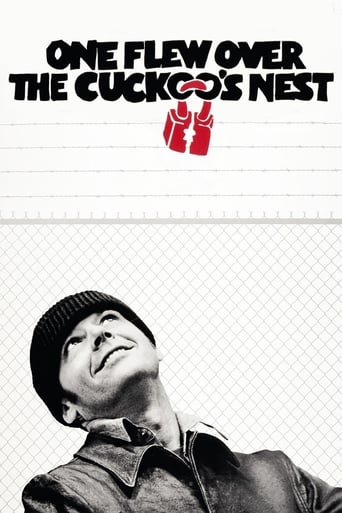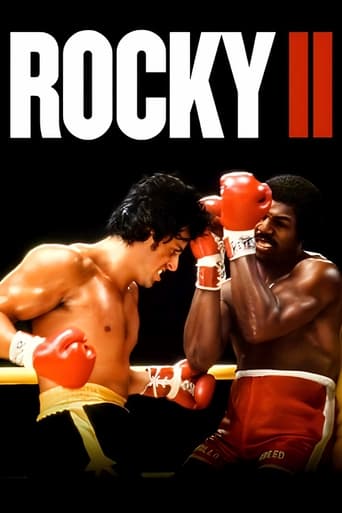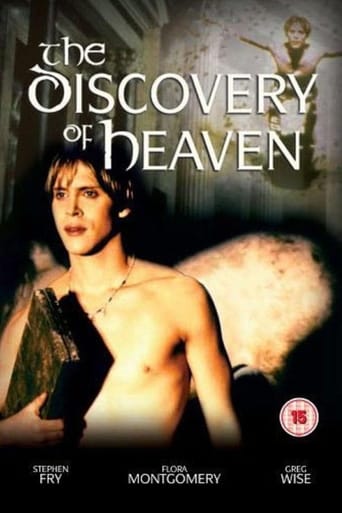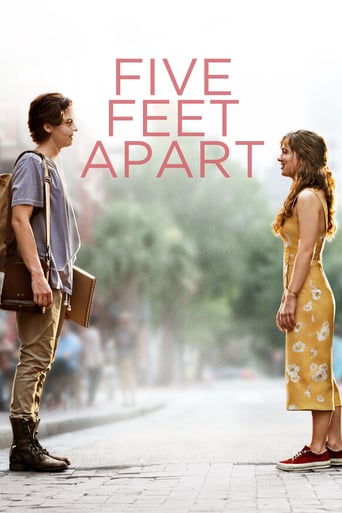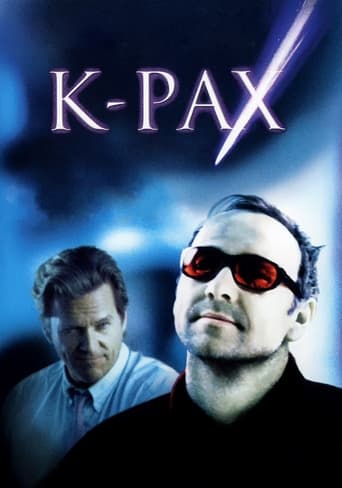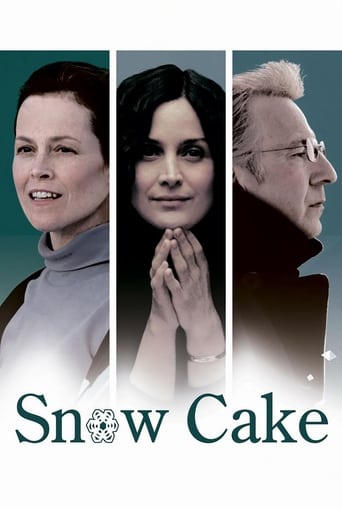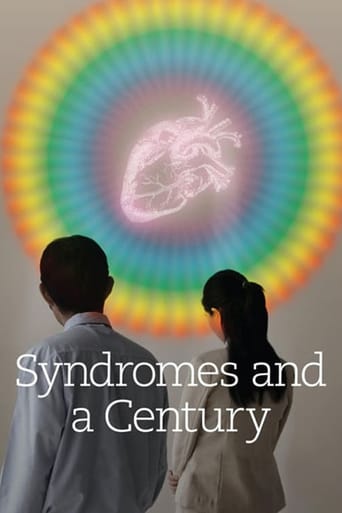
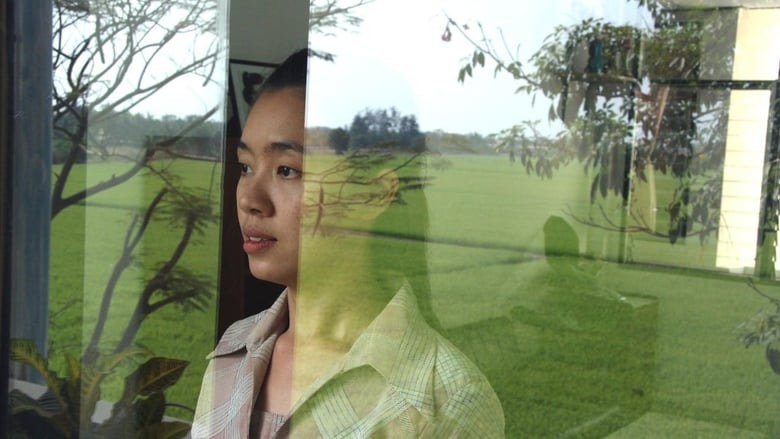
Syndromes and a Century (2006)
A story about director Apichatpong Weerasethakul’s parents who were both doctors, and his memories of growing up in a hospital environment.
Watch Trailer
Cast


Similar titles
Reviews
I love this movie so much
Yawn. Poorly Filmed Snooze Fest.
Simply A Masterpiece
It’s not bad or unwatchable but despite the amplitude of the spectacle, the end result is underwhelming.
"Normally I sing about teeth and gums, but this album is all love songs" With Syndromes & a Century, Apichatpong Weeresethakul sorta-makes his own version of Tarkovsky's Mirror: a fractured, beautiful, cyclical autobiography in cinema. But Tarkovsky's film was concerned with the whole: inward-facing, but dealing with lost innocence, a desperate search for God and the scope of human existence. Early in on his film, Weeresethakul seems much more interested in the part, the details, the specifics, the ground-level, the things you won't notice unless you stop, look and listen.From the very first shot, the warm, sensual atmosphere present throughout Tropical Malady is all around us again: the weather is impossibly pristine, the sun is shining, the trees are blowing in the breeze, and everyone is speaking in rich, hushed tones. The fact that this section of the film is mined from the mind of the director's childhood at his parents' practice jibes perfectly with what we see on screen: there's a gentle, nostalgic perfection to these scenes; I'm sure this is how every day is when he thinks back, and the camera, like a child, has a tangible presence in the frequent "adult" discussions, but is generally ignored by the subjects of the gaze as a non-entity. It's as if the young Apichatpong had a camera, and now he's looking part at the conversations he witnessed but didn't understand at the time, filtered through the sweet vibe he gets when he looks back.The other unexpected thing apparent right off the bat is how amusing the film is. Weeresethakul is secretly, quite possibly, the most approachable "arthouse" director out there, and one of the initial scenes involves the ostensible lead actress Dr. Toey (Nantarat Sawaddikul) meeting with a chatty monk who relates to her his fear that he has bad chicken-based karma because it comprises a large part of his diet and dreams of breaking chicken's legs, and then tries to hustle her for pain pills. Additionally, the ostensible male lead, Dr. Ple (Arkanae Cherkam) is a dentist-cum-amateur-country-singer, and one of the monks confesses during a cleaning that he once had aspirations to be a DJ and/or comic book store owner (Ple provides the quote at the top) The second half of the film shifts to the present day, transposing the same characters to a stifling, antiseptic modern hospital, and showing the same interactions from a contemporary standpoint: the opening interview between Toey and cheerful medic Dr. Nohng (Jaruchai Iamaram) is much more curt and nitpicky. The monk is advised to cut back on the chicken not because of bad karma, but bad cholesterol, and the brusque doctor immediately attempts to prescribe medication for the monk's "panic disorder". Meanwhile, the dentist and the younger monk's friendly interaction with the sun shining out the window has been replaced by rows of gleaming plastic machinery and absolute silence (to the point that most of the monk's face is covered in an almost-Cronenbergian hood), with the only conversation involved being instructions to open or close the mouth.It becomes quickly apparently that Weeresethakul's picture steers much closer to Tarkovsky than previously anticipated. Drifting into peer Tsai Ming-Liang's wheelhouse, his topic of conversation has become urban alienation; the subsequent loss of spirituality comes a loss of humanity. The key sequence comes around here, when the film cuts between achingly lonesome pans of religious statues neglected in small patches of urban foliage, and Dr. Nohng, on his lunch break, walking with a colleague discussing ringtones and leering at co-eds. The rest of the film runs in this vein: an older female doctor pulls liquor out of a prosthetic leg in preparation for an upcoming television appearance; a chakra healing attempt is angrily swatted away by a young patient who has a large tattoo on his neck and no desire to go to school; an intimate moment between Nohng and his significant other turns into a request for him to move with her to an ugly, high-tech "modern" area of town, and a vulgar gawk at his erection; culminating in a breathtaking sensory overload in the final sequence, wrapping up with a gloriously audacious, discordant series of shots that puts his theme in vivid focus.Social impatience, emotional disconnect, moral malfeasance, all are present in Weeresethakul's view of the present world, but he has done more than scream at the kids to get off his lawn, he's created a treatise on the state of the world: caring is in decline, kindness is in decline, focus is in decline, soul is in decline. I usually roll my eyes when a pundit begins rambling about the "good ol' days", but as a filmmaker, Weeresethakul is tasked with creating his own world, letting us share it, and making us believe it, and with Syndromes & a Century, he's presented us with the trappings of a very familiar modern world, and a hope, a wish, a prayer that maybe, just maybe, by journeying back to his childhood, if not our own, we could carve out a blueprint for how to be a little closer, a little kinder, a little wiser, towards our fellow man.--Grade: 9.5/10 (A)--
Thai film Syndromes and a Century manages to come across as an unashamedly routine love story told amongst a palette of long takes, highly ambiguous symbolism, a distinct manipulation of time and space as well as a telling of events from particular perspectives. The film is a high-art piece, with particular avant-garde sensibilities, as it weaves a tale that sways in and out of the past tense, the present tense and distinct and important memories as well as some sort of alternate reality. The film is very spiritual, and it carries that slow and methodical tone that compliments the delicate and somewhat sensitive subject matter of love, rejected love and life. The slow tracking camera as shots of about twenty seconds in length of stone Bhudda statues suggests whatever journeys these characters are on are more spiritual than they are physical.Syndromes and a Century isn't necessarily too concerned with narrative, and whatever development of its characters it does, or connection with them we feel with them, is going to be by way of relating to the fondness they feel for one another more-so the vast and complex changes they undergo. Instead, the film takes a step back; focusing more on camera and atmosphere, in particular, where the camera is situated just as much as it is concerned with where it isn't. There is a scene, very early on, in which the camera stands mere feet off the ground at a door-way and focuses on an individual of medical profession talking to various patients sitting to the side of this person's desk. The placement is pretty clear, and with synopsis in mind that this is a personal piece documenting memories of the director's parents as he spent time in the hospital in which they worked, the shot is quite clearly supposed to resemble a child's point of view; tepid as to whether to come in or not and insignificant enough for the people in the room to pretty much ignore them.But that's not to say the film is entirely told from a child's perspective, just those scenes that director Apichatpong Weerasethakul feels necessary to document in that grounded, lack of cuts and edits manner. Weerasethakul blends a very articulate sense of the observant during most of the internal scenes supposedly revolving around his parents working in respective spaces; shot through a camera that is very much a part of the scenes, but isn't directly involved in the action, with rather routine exchanges and dialogue sequences in which exactly how people feel for one another needs to be laid out and fast-tracked.This romance revolves around a young doctor who happens to be quite fond of what is the closest resemblance in the film of a lead role in a young, female nurse. When this individual eventually confesses his feelings outside in the hospital grounds, there is an entire segment of the film dedicated to a flashback of what I presume to be a prior love in the life of the nurse, a flower salesman by the name of Noom (Pukanok). Given the overall context of the piece and it being a recollection or acknowledgement of past events, the extended break away into the past tense of when the nurse is reminded of prior events fits the overall context of the film; that being as something that is all about delving into the past and remembering important times gone by; times that, indeed, may well have shaped an individual or had such an impact on them that it has made them the way they are.As the film progresses, scenes seem to repeat themselves, but from different angles in the room or at the location. Scenes play out from earlier on but cross the line and have the child-like perspective from a different position in what I can only assume is the director's recollection of the general area he frequented many times but, given how complicated and meaningless everything everybody ever said in these rooms was to a child anyway, a lot of the talk; dialogue and exchanges people engaged in with one another just seemed to blend in with everything else and sound the same. What's important in this regard is remembering how highly the visuals of the piece are emphasised by the director; this is a piece about observing and recalling places and people and how this had an impact on you in your life. What it isn't interested in is any particular aural detail: the dialogue between two people that love one another is deliberately unspectacular and the speech in the hospital comes close to exact repetition.As a piece that evokes a certain emotional response, Syndromes and a Century succeeds. It is a memorable experience about specific memories themselves, while being deliberately ambiguous and hazy in its set time-frame. Even some of the film's more outrageous content feels as if it can carry certain meanings without coming across as too pretentious. Take, for example, the air condition equipment sequence which acts as a visualisation of raw human emotion as the previously seen dust or smoke that had settled in the room is soaked up by a funnel, in a sort of visualisation of the bombshell of a few scenes ago in which a character proposes they move away with their love. The bombshell is dropped; the smoke litters the area but it is then all absorbed as the other individual comes to terms with what positive things that decision may incorporate. The film is stunning at the best of times, which is rather frequently, and doesn't really drop below a level of high, humbling quality.
It's important to point out that the films of Apichatpong Weerasethakul are clearly an acquired taste. This Thai director makes movies that bear only a passing resemblance to the kind of narrative-laced dramas with which audiences in the West are most comfortable and familiar. His works reflect a Buddhist philosophy of deep inner reflection and unhurried contemplation of the moment - and, thus, they demand patience and an open mind from the viewer. But those willing to sample the strange exotic brew that is "Syndromes and a Century" (the title itself is enigmatic) will find ample rewards in the consumption.There's little point in trying to explain what "Syndromes and a Century" is "about," since it serves no purpose to think of a Weerasethakul film in such terms. As a largely impressionistic work, the movie is more concerned with mood, feeling and setting than it is with conventional drama. Watching a Weerasethakul film is a bit like trying to solve a puzzle for which very few clues are provided. The "story," such as it is, involves two doctors - a woman working in a rural clinic and a man working in a big-city hospital - and their various encounters with patients, lovers and colleagues. We're told that the story was inspired by the romance of Weerasethakul's parents, though the obscurity of its presentation renders that explanation virtually meaningless. Often, an earlier scene is enacted a second time, though in an entirely different setting and from an opposing angle. This leads to even more confusion on the part of the viewer.But it is style, rather than plot, that is of primary importance here. "Syndromes and a Century" is comprised almost entirely of beautifully composed and rigorously sustained medium and long shots, with few close-ups, very little camera movement and only minimal editing within scenes. Thus, even though we may not always understand fully what is going on, we are lulled into the movie by the seductive, hypnotic rhythms and style of the film-making."Syndromes and a Century" is not as compelling as Weerasethakul's previous film, the lushly transcendent and utterly spellbinding "Tropical Malady," but it should definitely appeal to anyone with a taste for the enigmatic, the exotic and the abstract.
While the experiments with memory and non-sequential progress through the film are interesting, my final reaction was so what.What was Weerasethakul trying to achieve that Resnais had already done far better in L'Année dernière à Marienbad. The formalisms explored through the retelling of stories at a different time and place were intriguing but there were none of the power of the imagery of Marienbad. Images from Marianbad live with me 30+ years later. These ones won't and not only because I'll be dead by then.It was two hours on the edge of tedium, but the skill was you stayed on the edge not fell into ennui. But I had no sense when I left the cinema that I had had a true aesthetic experience or provided me with images to refract new experiences through.Maybe hotels do more for me than hospitals, I don't know.



